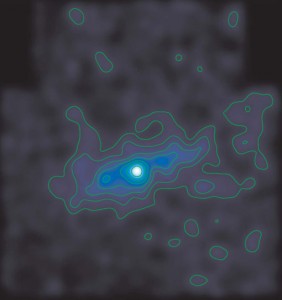
Life and Death of a Hero – or what we can learn from modelling the dwarf spheroidal galaxy Hercules
These very faint galaxies were detected through analysing the star catalogue data from the Sloan Digital Sky Survey, containing the information of about 60 million stars in the Northern hemisphere, by the Cambridge group of Belokurov et al. in 2007.
In their paper ‘Cats and Dogs, a Hair and a Hero’ they describe the detection of 5 new ultra-faint dwarf galaxies in the vicinity of the MW and named them after the constellation they can be found in: Leo IV (and a lion is nothing but a very big cat), Canes Venatici II (the hunting dogs of Bootes the herdsman), Coma Berenice (the hair of Berenice II, queen of Egypt) and finally the well-known Greek hero Hercules.
In the years that followed other observational groups determined the intrinsic properties of the Hercules dwarf galaxy. They determined its total luminosity (measuring how many stars has this galaxy), its central brightness and its very elongated shape. Others determined the internal velocity dispersion (how fast are the stars moving around inside the Hercules galaxy) and found that the galaxy may have a gradient in radial velocity along its elongation. If this gradient is due to tidal interactions with the MW (i.e. the gravitational force of the MW is pulling the dwarf galaxy apart) astronomers can determine a probable orbit of Hercules.
This is how a researcher group from Universidad de Concepción, led by Michael Fellhauer continues the study of these dwarf galaxies nearby the Milky Way, but its evolution sheds mysterious results. Dr. Fellhauer explain:
“In our study we use this orbit and try to find a possible progenitor (how did the galaxy look in the past). To do this we place a possible progenitor model onto the position of Hercules in the past. Then we use numerical simulations to follow its evolution from the distant past (ten thousand million years) until today. A possible progenitor is found once the remnant of the galaxy today in our simulations matches all the observational data we have.”
In the search for the best match to the data researchers encountered a severe problem. Hercules has a very thin elongated shape and they were unsuccessful to match this strong elongation at the same time as the angular orientation in the sky. “The more destroyed our final models got, by the gravitational forces of the MW, the more elongated (along the orbit, i.e. with the correct angular orientation) our models are. But this trend only holds up to a point in which the very destroyed remnants flip their angular orientation to be almost perpendicular to the orientation of the orbit. And only then we reach the correct elongation.
The reason for this flip can be explained by the theory of how these destructive elongations (called tidal tails) are produced. At each passage of the closest point (with respect to the centre of the MW) of a dwarf galaxy’s orbit, the satellite will lose stars due to the gravitational pull of the MW. These stars escape along a line oriented towards and away from the centre of the MW. Only with time, the next time the satellite reaches its furthest distance to the MW, these tails align themselves along the orbital path. “In our case, Hercules had already had multiple closest passages and has not yet completed the next passage through the furthest point. Therefore, we see something, we call the ‘X-wing effect’. Like the rebel fighter ships from Star Wars, four ‘wings’ emerge from the satellite – two ‘old’ tails and two ‘new’ ones. The two new tails have not yet had the chance to align completely with the older ones. Normally, the ‘old’ tails outshine the ‘new’ ones and we see an elongation of Hercules along its orbit. But in the final stages of destruction, i.e. the destruction we need to explain the elongation, the ‘new’ tails of our models will outshine the ‘old’ ones, causing the flip in the visible orientation.”
The lack of success to match elongation and orientation at the same time can only be explained by those possibilities:
(1) the orbit which was determined for Hercules is wrong
(2) the measured elongation is wrong
(3) the elongation and the gradient in velocities is not due to
forces of the MW but some intrinsic properties of a dwarf galaxy
which is heavily shielded by a dark matter halo.
If the third possibility is the correct one, then we have no chance to deduce the orbit of Hercules. Its orbital path can be oriented in any possible direction. Nevertheless, as the theory group has found suitable models to explain such strange intrinsic features without using external forces in the past, there is still an idea about how the hero in space looked like when he was young.
* Blaña, M., Fellhauer, M., Smith, R., Candlish, G.N., Cohen, R., Farías, J.P. 2015, “Life and death of a hero – lessons learned from modelling the dwarf spheroidal Hercules: an incorrect orbit?”, MNRAS 446, 144-159





